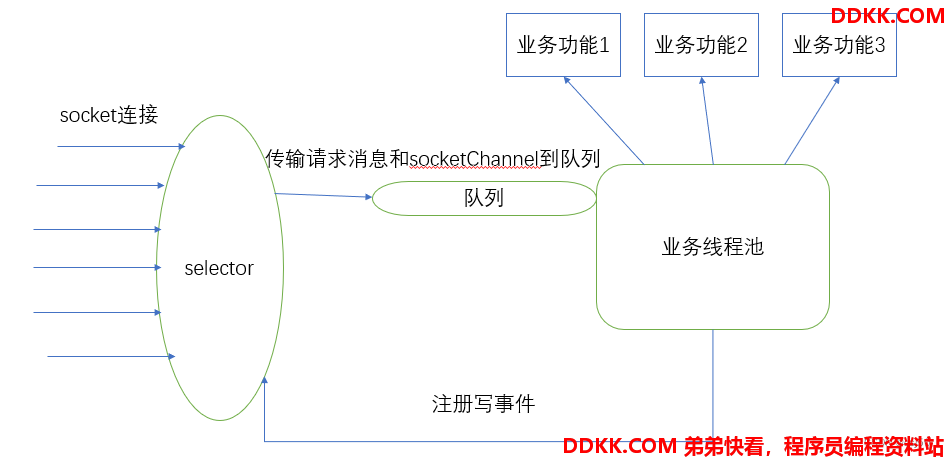一、案例
1、 编写一个NIO入门案例,实现服务器端和客户端之间的数据简单通讯(非阻塞);
2、 目的:理解NIO非阻塞网络编程机制;
3、 代码;
NIOServer.java
package netty.niostart;
import java.io.IOException;
import java.net.InetSocketAddress;
import java.nio.ByteBuffer;
import java.nio.channels.SelectionKey;
import java.nio.channels.Selector;
import java.nio.channels.ServerSocketChannel;
import java.nio.channels.SocketChannel;
import java.util.Iterator;
import java.util.Set;
public class NIOServer {
public static void main(String[] args) throws Exception {
//创建ServerSocketChannel -> 类似于ServerSocket
ServerSocketChannel serverSocketChannel = ServerSocketChannel.open();
//得到一个Selector对象
Selector selector = Selector.open();
//绑定一个端口6666,在服务器端监听
serverSocketChannel.socket().bind(new InetSocketAddress(6666));
//设置为非阻塞
serverSocketChannel.configureBlocking(false);
//把serverSocketChannel注册到selector,关心事件为OP_ACCEPT
serverSocketChannel.register(selector, SelectionKey.OP_ACCEPT);
//循环等待客户端连接
while(true) {
if (selector.select(5*1000) == 0) {
//等待5秒钟,如果没有事件发生,返回
System.out.println("服务器等待了5秒,无连接");
continue;
}
//如果返回的>0,就获取到相关的selectionKey集合
//1.如果返回的>0,表示已经获取到关注的事件
//2.selector.selectedKeys()返回关注的集合
//3.通过selectionKeys反向获取通道
Set<SelectionKey> selectionKeys = selector.selectedKeys();
//遍历集合
Iterator<SelectionKey> keyIterator = selectionKeys.iterator();
while (keyIterator.hasNext()) {
//获取到SelectionKey
SelectionKey key = keyIterator.next();
//根据key,对应的通道发生的事件,做相应的处理
if (key.isAcceptable()) {
//如果是OP_ACCEPT,有新的客户端连接
//给该客户端生成一个SocketChannel
SocketChannel socketChannel = serverSocketChannel.accept();
//将socketChannel设置为非阻塞模式
socketChannel.configureBlocking(false);
//将客户端的socketChannel也注册到selector,关注事件为SelectionKey.OP_READ
//同时给该socketChannel关联一个buffer
socketChannel.register(selector, SelectionKey.OP_READ, ByteBuffer.allocate(10240));
System.out.println("from " + socketChannel.hashCode() + " 客户端建立了连接");
} else if (key.isReadable()) {
//发生OP_READ
//通过key反向获取到对应的channel
SocketChannel socketChannel = (SocketChannel)key.channel();
//获取到该channel关联的buffer
ByteBuffer byteBuffer = (ByteBuffer)key.attachment();
byteBuffer.clear();
//把当前通道的数据读到buffer中
try {
if (socketChannel.read(byteBuffer) == -1) {
System.out.println("from " + socketChannel.hashCode() + " 客户端断开了连接");
keyIterator.remove();
socketChannel.close();
continue;
}
//解析客户端数据
//socket通讯格式可以自己定义:4字节报文长度+报文体
String request = new String(byteBuffer.array(), 0, byteBuffer.position(), "utf-8");
System.out.println("from " + socketChannel.hashCode() + " 客户端:" + request);
//----------------------------------------------------------------//
/**
* 业务模块处理(能否做成异步,传入socketChannel对象)主线程只负责网络IO读写
*/
//业务处理
System.out.println("业务处理...");
//使用新buffer返回
ByteBuffer newByteBuffer = ByteBuffer.allocate(10240);
newByteBuffer.clear();
//获取返回数据
String response = "result ok";
newByteBuffer.put(response.getBytes("utf-8"));
newByteBuffer.put((byte)'9');
//注册写事件
socketChannel.register(selector, SelectionKey.OP_WRITE, newByteBuffer);
//----------------------------------------------------------------//
} catch (IOException ioe) {
ioe.printStackTrace();
keyIterator.remove();
socketChannel.close();
continue;
}
} else if (key.isWritable()) {
//通过key反向获取到对应的channel
SocketChannel socketChannel = (SocketChannel)key.channel();
//获取到该channel关联的buffer
ByteBuffer byteBuffer = (ByteBuffer)key.attachment();
//读写切换
byteBuffer.flip(); //只有buffer出数据需要切换
//把buffer数据写入到channel
try {
socketChannel.write(byteBuffer);
} catch (IOException ioe) {
ioe.printStackTrace();
keyIterator.remove();
socketChannel.close();
continue;
}
String response = new String(byteBuffer.array(), 0, byteBuffer.position(), "utf-8");
System.out.println("to " + socketChannel.hashCode() + " 服务端:" + response);
//如果长连接继续注册事件等待
//注册读事件
//socketChannel.register(selector, SelectionKey.OP_READ, ByteBuffer.allocate(10240));
//如果短连接则断开
socketChannel.close();
} else if (key.isConnectable()) {
System.out.println("Connectable");
} else if (key.isValid()) {
System.out.println("Valid");
}
//手动从集合中移除当前的SelectionKey,防止重复操作
keyIterator.remove();
}
}
}
}
NIOClient.java
package netty.niostart;
import java.net.InetSocketAddress;
import java.nio.ByteBuffer;
import java.nio.channels.SocketChannel;
public class NIOClient {
public static void main(String[] args) throws Exception {
//得到一个网络通道
SocketChannel socketChannel = SocketChannel.open();
//设置非阻塞模式
socketChannel.configureBlocking(false);
//提供服务器端的ip和端口
InetSocketAddress inetSocketAddress = new InetSocketAddress("127.0.0.1", 6666);
//连接服务器
if (!socketChannel.connect(inetSocketAddress)) {
while(!socketChannel.finishConnect()) {
System.out.println("因为连接需要时间,客户端不会阻塞,可以做其他工作");
}
}
//如果连接成功,就发送数据
String str = "111";
//客户端也要关联buffer
ByteBuffer byteBuffer = ByteBuffer.wrap(str.getBytes("utf-8")); //根据字节数组产生buffer
//Thread.sleep(30*1000); //模拟线程阻塞
//发送数据
//将buffer数据写入channel
socketChannel.write(byteBuffer);
//获取返回
byteBuffer.clear();
int numBytesRead;
while ((numBytesRead = socketChannel.read(byteBuffer)) != -1) { //-1是读完
if (numBytesRead == 0) { //0是读到0个
if (byteBuffer.limit() == byteBuffer.position()) {
byteBuffer.clear();
}
continue;
}
//buffer是数组用这个
//System.out.println("客户端收到:" + new String(byteBuffer.array(), byteBuffer.arrayOffset(), byteBuffer.arrayOffset()+byteBuffer.position(), "utf-8"));
//单个buffer用这个
System.out.println("客户端收到:" + new String(byteBuffer.array(), 0, byteBuffer.position(), "utf-8"));
}
System.out.println("断开连接...");
socketChannel.close();
//System.in.read();
}
}
二、用telnet测试
1、 打开cmd;
2、 执行:chcp65001,将编码方式改为“utf-8”;
3、 telnet连接;
4、 按Ctrl+];
5、 执行sendxxx;
6、 但是telnet传输字符长度有限制?;
三、服务端设想

1、 前端请求建立socket连接;
2、 网络通讯为NIO模型;
3、 将请求消息和socketChannel对象传到一个队列;
4、 业务模块维护一个线程池从队列获取请求并处理,还是一请求一线程模式;
5、 业务线程处理完成后注册写事件,结束;
这样网络读写是异步的,通讯和业务处理也是异步的